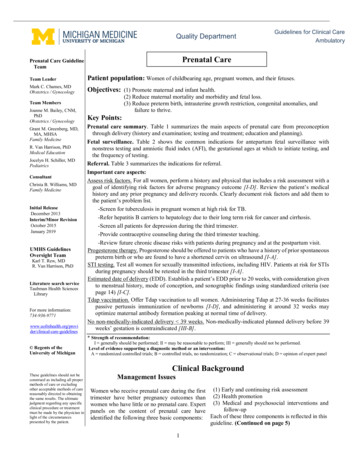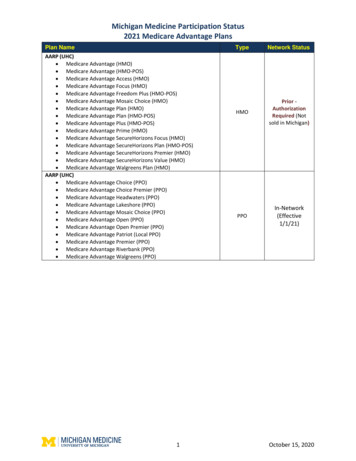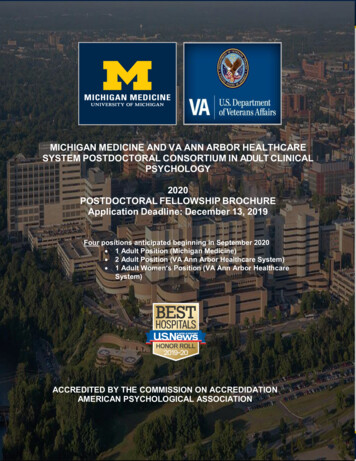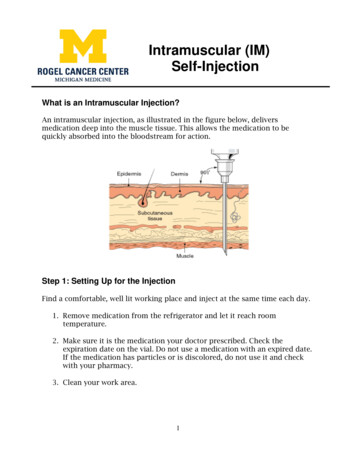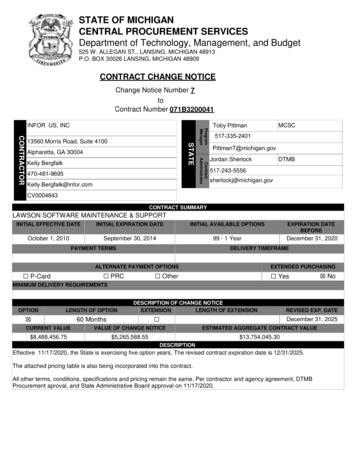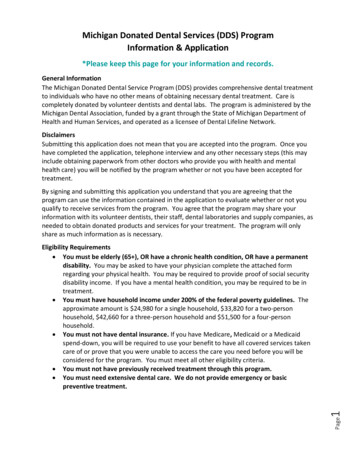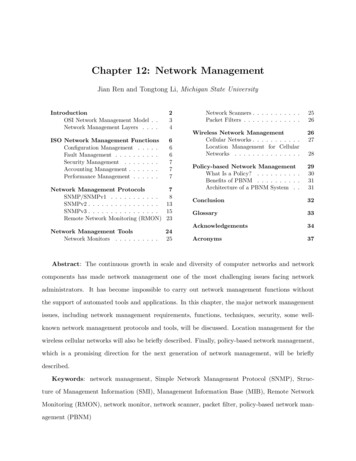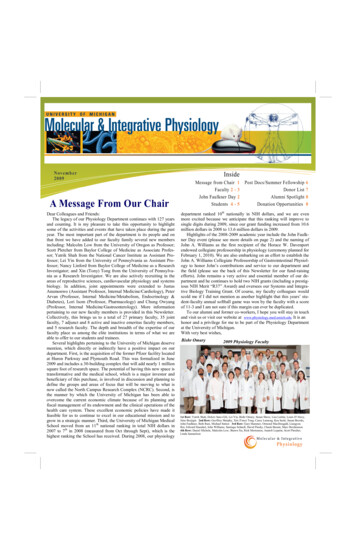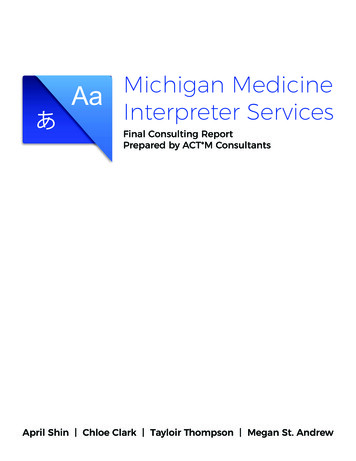
Transcription
Michigan MedicineInterpreter ServicesFinal Consulting ReportPrepared by ACT*M ConsultantsApril Shin Chloe Clark Tayloir Thompson Megan St. Andrew
Table of ContentsExecutive Summary3Introduction4Background5Methodological Overview8Alternative Interpretation MethodsLEP Patient FocusThe MiChart SystemInterpreter ServicesProject GoalCurrent Institutional Solutions for Interpretation Services:Speaking TogetherTechnological Innovation in Interpretation Services:Video Remote InterpretingContextual InquiryInterviewsQualitative AnalysisFindings and Recommendations10Conclusion17Works Cited18Team Biographies19Alternative Interpretation MethodsLEP Patient FocusMiChart2
Executive SummaryMichigan Medicine has experienced inefficient staffing issues in providing interpreterservices. Since a total two million patients use its services and represent differentdemographics, interpreter services are integral to best provide patient care. However,the institution is having difficulty in scheduling interpreters with patients due to lackof an efficient booking system. Around 65% of interpreters are scheduled the daybefore the appointments, and there are many reported cases that patients eithermissed the opportunity to have an interpreter or had to wait too long to get assignedappropriate interpreters. In the worst cases, service providers have failed to deliverproper medical service due to this lack of medical interpreters. In this regard, theclient is looking for a better way to staff interpreters, and ideally seeks for staffinginterpreters on-demand.To assess the challenges, our team conducted contextual inquiries and personal indepth interviews with key players from Michigan Medicine Interpreter Services inorder to understand their overall work processes and daily workflow. The study wasconducted over the past four months based on rigorous qualitative research, insightfulfindings and interpretation sessions. This report documents methodology, keyfindings, and final recommendations. Key findings and recommendation summary isas follows:Alternative Interpretation MethodsWhile in-person interpretation services are often preferred by providers andinterpreters, with over 2,000 requests per month and limited resources, it is impossibleto provide an interpreter for each patient appointment at Michigan Medicine. Asa result, alternative interpretation methods, such as remote telephonic or videointerpreting must be explored.LEP Patient FocusWhile Interpreter Services exemplifies patient-focused values for LEP patients, trainingissues and other problems with clinics and hospitals makes it appear as if others inthe health system are unaware of how to best care for LEP patients. As a result, theissue from lack of awareness of the importance of LEP patient’s care from all relatedparties should be addressed in a timely manner.The MiChart SystemWe found that inefficiencies in the Michart system often leads to overbooking orunderbooking, leading to overall inefficient staffing of interpreters as one of the rootcauses of Interpreter Services’ staffing problems. Because Interpreter Services is ableto make requests to MiChart for overall system changes, we identified multiple placesfor improvement and suggested recommendations in the current MiChart system.3
IntroductionInterpreter ServicesMichigan Medicine Interpreter Services is an organization that provides interpretiveservices for the greater University of Michigan Medical System, including clinics inPlymouth, Livonia, and Howell. They currently have over 2,000 requests per month forinterpretation of more than 70 languages, including Deaf, Deaf/Blind, and LimitedEnglish Proficiency (LEP) patients. They provide face-to-face interpretation services,“high-quality telephone interpreting” (UMHS Interpreter Services), and are lookingto expand into video remote interpreting (VRI) within the next year (Gatonez).Ambulatory care—of which Interpreter Services is a part—has set a benchmark goal for80% of interpretive services to be conducted face-to-face (Gatonez).Interpreter Services currently employs about 100 interpreters but their roles aredependent on language spoken and hours worked per week. There are 44 staffinterpreters, 20 contract sign language interpreters, 4 administrative staff, and about40 temporary employees (UMHS Interpreter Services). Spanish, Mandarin, Arabic, andSign Language are the four most commonly requested services (Gatonez).Project GoalAlthough Interpreter Services is committed to providing the best quality healthcareto all patients regardless of English language capability, there are inefficiencies intheir patient scheduling system that can result in confusing day-off reschedulingprocedures at best and full appointment cancellations at worst. Interpreter Servicesclaims this is the result of clerks incorrectly scheduling interpreters due to unintuitivescheduling procedures and lack of LEP patient focus. They currently employ differentstrategies, such as MiChart worklists, clerk training, phone interpretation, and videoremote interpreting (VRI) prototyping in order to solve these issues but still recordinefficiencies. In order to ensure the best possible health outcomes, MichiganMedicine Interpreter Services would like to better optimize their scheduling processin order to take full advantage of their limited staff and successfully help the highnumber of LEP patients that use the service.4
BackgroundCurrent Institutional Solutions for Interpretation Services: Speaking TogetherSpeaking Together: National Languages Service Network (hereafter, SpeakingTogether) is a national collaborative founded in 2005 that brings together 10different hospitals in order to foster interdisciplinary health solutions for LEP patients.In practice, these hospitals test different interpreter service solutions in order to“identif[y] effective ways to reduce ethnic and racial disparities in the quality of patientcare providing tools that health systems can use to improve the overall quality of caredelivery” (Regenstein, Huang 3). Speaking Together’s main goals are creating nationalstandards of care for (1) quality of language services, (2) quality performance measureimplementation, and (3) research pertaining to the effect of effective language servicedelivery on chronic disease management (Regenstein, Huang 3). Michigan Medicine isa member of this collaborative. The quality control measures established by SpeakingTogether are based on the Institute of Medicine’s Six Domains of Quality to LanguageService (Table 1).Speaking Together further defined the standards listed below for “qualified”interpreter and bilingual providers. However, Speaking Together left it to the10 hospitals to determine the definition and practice of “quality” interpretation(Regenstein, Huang 6).1. Bilingual staff or providers who have been assessed for proficiency in thelanguage(s) for which they provide care.2. Medical interpreters who have been trained in medical interpreting methodsand protocols and assessed for language proficiency.After careful research and communication with participant hospitals, SpeakingTogether proposed the following performance measures utilizing a patient-centeredframework in order to study the effects of standardization of language services overtime (Table 2).Table 1Table 25
Background cont.Speaking Together also required participant hospitals to engage with non-interpreterhospital staff in order to adequately implement these performance measures.Regenstein and Huang (10) report:a changerequiredhospitalsto interact,directlyor indirectly,Such“Sucha changerequiredhospitalsto interact,eithereitherdirectlyor bouttheimportanceofaskingregistration staff to educate them about the importance of asking about onsabout couldhow thelanguage,suggestionsabouthowthe informationbe informationrecorded, andcould berecorded,and encourageto routinelycollectthe anotherinformation,encouragethemto routinelycollect thetheminformation,despiteaddingdespite fieldaddinganotherinformationfield to the registration process.”informationto theregistrationprocess.This is important to note because Speaking Together has not only orchestrated aconcentrated effort to implement national professional and performance standardsbut also requires these standards to be hospital-wide in implementation, somethingthat has often been unclear in the past, leading to confusion on the part of clinics(Jimenez 16-26). Likewise, other research finds hospital-wide policy statementspromoting “service culture” for LEP patients is just as important as ensuring access toprofessional interpreters in order to deliver quality language services (Hudelson).The Speaking Together collaborative ultimately resulted in increased performancebased on their five proposed performance measures and a shift in hospitalwide attitudes towards recognition of the necessity of quality language services,representing the importance of implementing changes and following standardizedperformance measures (RWJF 13).Because Michigan Medicine Interpreter Services is already a member of SpeakingTogether, many issues of standardization are already being implemented. However,UMHS has emphasized only part of these standards by focusing on the performancemeasures but failing to integrate Interpreter Services into a greater intra-hospitalsetting (RWJF 21), resulting in continuing inefficiencies on the part of non-interpreterstaff (Participant 1).Technological Innovation in Interpretation Services: Video Remote InterpretingBesides phone interpretation services, video remote interpreting (VRI) has alsobecome an alternative to face-to-face interpretation recently, especially for thosehospitals which continue to struggle with hiring quality interpreters as followingSpeaking Together standards. Video services are not only more cost effective andconvenient, but also “improve access and quality of care to LEP persons ” (Masland739). As well as this, VRI has documented improvements over telephone-basedinterpretation, further improving efficiencies of interpreter services during periods ofoverbooking (Price 226).Michigan Medicine Interpreter Services is currently in the process of prototyping a VRIsystem for their organization due to inefficiencies encountered in current schedulingprocesses, hostility of providers towards past phone interpretation methods, and thepotential to generate revenue by expanding their renowned interpretation servicesbeyond the circle of UMHS (Gatonez).Technological Innovation in Interpretation Services: Electronic Health RecordMichigan Medicine Interpreter Services uses MiChart, an electronic health record(EHR) software program, for the scheduling of interpreters to the LEP patients that6
Background cont.require them. Almost all aspects of patient care are accessed through MiChart,including patient registration and scheduling, transportation services, billing, andpatient care orders (MiChart). All approved hospital staff—around 26,000 people—canaccess MiChart and see past and future visits, assign changes to a patient’s record, andschedule appointments (Swiderski).Speaking Together includes guides for optimal use of this technology in their initialreport on performance measures for hospital language services, informing hospitalsthat they should meet with IT staff in order to include interpreter registration intheir systems (Regenstein, Huang 10). InDemand Interpreting, a technology-enabledlanguage services organization, has created guidelines for effective language serviceespecially related to EHR, noting the following relevant technological and data drivenmethods of effective interpreter services:1. Make the preferred language a “stop field” in the software program2. Track your interpreter requests3. Compare your interpreter request numbers to the Information Desk and/orRegistration numbers4. Facilitate the documentation on the Electronic Medical Record (EMR) soproviders can accurately document the language and the fact that aninterpreter was used for the encounter.5. It is common for patterns of usage to show which will help youstaff accordingly— For example, Mondays is traditionally a heavy interpreter use day— Fridays tend to be lighter in volume6. Know the number of requests for your top languages and— Track daily/monthly requests— Track requests by location7
Methodological OverviewContextual InquiryIn efforts to produce sufficient recommendations for the Michigan MedicineInterpreter Services improper scheduling issue our team followed a human-centeredapproach for comprehending internal processes by utilizing contextual inquirytechniques. Contextual inquiry consists of gathering field data and requirementsby observing an organization’s day-to-day work activities in order to determine aconsensus about the workflow in the context of its environment (Holtzblatt 16). Ithas become a standard within the industry when it comes to analyzing qualitativedata. Being able to observe and capture various processes within the InterpreterServices workflow enabled the team to see different work dynamics and allowed usto produce more concrete analysis. Using the contextual inquiry methodology overthe course of the semester our team conducted interviews, observed employees,collected artifacts, and interpreted results via affinity diagrams--all of which assisted usin formulating recommendations for Interpreter Services.InterviewsWe interviewed a total of five employees within Interpreter Services, each interviewlasting between 45 to 60 minutes. Our main objective for conducting interviews wasto determine the bases of the Interpreter Service’s scheduling problem and how theirwork activities potentially influence or contribute to this issue. Two members from theteam conducted each interview: one as interviewer, the other as documenter. Duringour initial interview, we were able to develop a better understanding of the InterpreterServices and the impact it has on patients and Michigan Medicine as a whole. Thefollowing interviews provided insight into how various roles within the InterpreterServices and the utilization of internal systems such as MiChart work together toschedule interpreters for patients. From our observations, we were exposed to a8
Methodological Overview cont.number of different system tools the Interpreter Services use, such as Snapboard, thatfunction simultaneously to schedule interpreters.From our second interview, we learned that approximately 1 in 100 patients needinterpreters, meaning clinics may not be familiar with the process of schedulinginterpreters, perhaps leading to the recorded inefficiencies of the current schedulingprocesses. The team also gained a better understanding of the relationship betweenInterpreter Services and clinic clerks. Moreover, we learned about the variouscommunication platforms such as Skype messenger and pager services which servesas the main modes of communication between interpreters and the interpreterschedulers. During our final interview, we were able to discern a reoccurring [patternacross all interviews regarding the gaps of times interpreters are busiest and thusmost often overbooked: 8:00am -12:00pm and 3:00pm-5:00pm.Qualitative AnalysisAfter our team completed conducting client interviews, we began to interpret,review and analyze the data we have obtained from interviews and observations.Interpretation sessions were held shortly after our interviews with InterpreterServices in order to analyze our findings. These sessions consisted of an interviewer,a note taker, and a general interpretation team member. The notes taken from ourinterpretation session were then annotated, allowing the team to clarify unansweredquestions and increase our comprehension of the data gathered from the interviews.This enabled us to develop a more concrete analysis of our findings. The next step ofour analytical process was the construction of our Affinity Wall. An Affinity Wall canbe used to make sense of a large amount of qualitative information. As seen in theimage below each sticky note represents a single interpretation of the data collectedfrom our interviews (Figure 3). The summarization of the notes enabled the team toidentify patterns and develop new conclusions. Each of the sticky notes were groupedinto a hierarchy of various clusters, with red notes representing our two main findings-interpersonal and infrastructure problems with the current scheduling processes.Along with interview observations, the Affinity Wall was essential for analyzing allpieces of qualitative data and producing recommendations for Interpreter Services.Figure 39
Findings and RecommendationsAlternative Interpretation MethodsWhile in-person interpretation services are often preferred by providers andinterpreters, with over 2,000 requests per month and limited resources it is impossibleto provide an interpreter for each patient appointment at Michigan Medicine. Asa result, alternative interpretation methods, such as remote telephonic or videointerpreting, must be explored. Based on our findings and research, integrating thesetechnologies will improve the staffing issues articulated by the client in our initialmeeting.Finding 1Phone interpretation is neither the preferred or most effective method of providinginterpreting services to LEP patients, but eliminating this service could potentially leadto legal issues.EvidenceTelephone interpretation, calls to Interpreter Services, and otherlast-minute interpretation measures are not efficient systems and lack equaland professional standards of care for LEP patients, resulting in frustration onthe part of clinics, interpreters, and patients. From our interviews we learnedthat less than 40% of patients who were assigned phone interpretationwere actually using the service (Participant 2). Moreover, there is no cleardata or documentation of what happens to the patients who choose not touse the interpreter phone method as providers and patients fail to followup with Interpreter Services. This option is not as effective as in-person andVRI options (Price 226) and is less popular (Participant 2). As well as this, theloss of visual information sometimes reduces interpretation quality (Masland742). Additionally, physicians within the Michigan Medicine Health Systemoften resist using these services even when other options are unavailable,risking patients’ ability to understand their diagnoses and treatment options. Inaddition to the effect this resistance has on patient satisfaction, there aresignificant legal implications for refusing to provide interpretation services.Under the ADA and the Civil Rights Act, physicians are required to provide aninterpreter for LEP patients (Bishop 2012). While telephone interpreting shouldnot be relied on as a primary method of serving LEP patients, when embracedand used correctly, it can provide impromptu interpreter services to avoid legaland ethical troubles.Recommendation 1 (Mid-term)Eliminating telephonic interpreting completely could leave providers withoutoptions when other interpretation services are unavailable, exposing MichiganMedicine to potential legal and ethical issues. However, this method is notas effective as VRI and in-person interpreting, so overuse of telephonicinterpreting can lead to lower levels of patient satisfaction and reducedinterpretation quality. We recommend utilizing telephonic interpretation onlyas an emergency measure when all other options have been exhausted to helpMichigan Medicine avoid legal ramifications.10
Findings and Recommendations cont.Finding 2Video Remote Interpreting (VRI) is an effective method for providing interpretingservices to LEP patients when it is not possible to provide the patient with an inperson interpreter.EvidenceVideo remote interpreting (VRI) has become an alternative toface-to-face interpretation, espe
strategies, such as MiChart worklists, clerk training, phone interpretation, and video remote interpreting (VRI) prototyping in order to solve these issues but still record inefficiencies. In order to ensure the best possible health outcomes, Michigan Medicine Interpreter Servic
